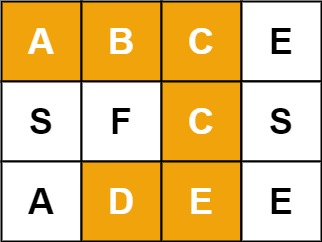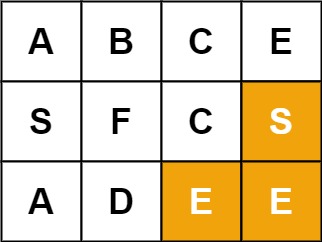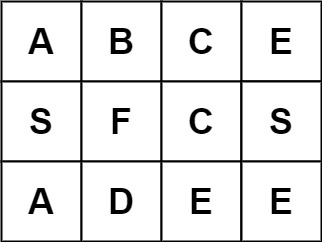LeetCode-in-All
79. Word Search
Medium
Given an m x n grid of characters board and a string word, return true if word exists in the grid.
The word can be constructed from letters of sequentially adjacent cells, where adjacent cells are horizontally or vertically neighboring. The same letter cell may not be used more than once.
Example 1:

Input: board = [[“A”,”B”,”C”,”E”],[“S”,”F”,”C”,”S”],[“A”,”D”,”E”,”E”]], word = “ABCCED”
Output: true
Example 2:

Input: board = [[“A”,”B”,”C”,”E”],[“S”,”F”,”C”,”S”],[“A”,”D”,”E”,”E”]], word = “SEE”
Output: true
Example 3:

Input: board = [[“A”,”B”,”C”,”E”],[“S”,”F”,”C”,”S”],[“A”,”D”,”E”,”E”]], word = “ABCB”
Output: false
Constraints:
m == board.lengthn = board[i].length1 <= m, n <= 61 <= word.length <= 15boardandwordconsists of only lowercase and uppercase English letters.
Follow up: Could you use search pruning to make your solution faster with a larger board?
Solution
object Solution {
private val directions = Array(Array(-1, 0), Array(1, 0), Array(0, -1), Array(0, 1))
private var numRows, numCols = 0
def exist(board: Array[Array[Char]], word: String): Boolean = {
if (board.length == 0) return false
if (word.isEmpty) return true
numRows = board.length
numCols = board(0).length
var result = false
for (row <- 0 until numRows if !result) {
for (col <- 0 until numCols if !result) {
if (board(row)(col) == word(0)) {
result = backTracking(board, row, col, word, 0)
}
}
}
result
}
private def backTracking(board: Array[Array[Char]], row: Int, col: Int, word: String, index: Int): Boolean = {
if (index >= word.length) return true
if (row < 0 || row >= numRows || col < 0 || col >= numCols || board(row)(col) != word(index) || board(row)(col) == '0') {
return false
}
val originalValue = board(row)(col)
board(row)(col) = '0'
var output = false
for (dir <- directions if !output) {
val newRow = row + dir(0)
val newCol = col + dir(1)
output = backTracking(board, newRow, newCol, word, index + 1)
}
board(row)(col) = originalValue
output
}
}

